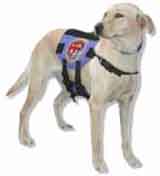Dog Behavior Problems and TrainingHow To Help Your Dog's Storm Phobias |
|
|
Many dogs that fear thunderstorm activity also fear other sharp percussive noises, such as gunfire, exploding balloons, or low frequency sounds from a sound system capable of rattling the windows. Because storm noises originate outdoors, any attempts to simulate storm noises or other loud sounds should originate there. These can be tested and used with a routine which involves a single hand clap, followed immediately by praise and introduction of some toy or other stimulus the dog associated with happiness. These staged performances should be repeated until the dog acts happy in response to loud noises, without use of the above routine. After this stage, it is still advisable to follow the same steps required for dogs that do not respond to staged percussion. If gunfire is to be used in these sessions, the shells used must be hand-loaded, low-powder blanks. The gun should be fired outdoors into thick, soft material, such as an old pillow. Only adults experienced with firearms should be involved. Also, neighbors should be forewarned of training sessions. If the dog does not respond to attempts at recreating storm sounds, the solution becomes more difficult, as one cannot conjure up storms at will. However, one can watch the weather forecasts carefully and make preparations at least 3-4 hours before a storm is due. This long lead time is necessary because many phobic dogs begin to show anxiety as falling barometric pressure indicates impending storms. In these situations, the training routine must be applied at the first sign of anxiety in the dog, and then reapplied until the dog shows upbeat behavior instead of the former anxiety, without any need for the routine. Sedatives: If the owner cannot be present to apply these procedures before and during storms, sedatives and tranquilizers may be used to reduce the dog's anxiety. However, without behavioral therapy, such drugs have not been effective over the long term. Desensitizing With Sound and Light: Though several authorities have recommended playing low-level thunder recordings and gradually increasing the volume as the dog accommodates to it, others in this field have not been successful with this technique. For years trainers have tried using recordings of thunder, coupled with flashing strobe lights, without success. This is probably because of 2 factors unique to storms. First is the lack of barometric pressure changes. Second is lack of the intense (to the dog) percussive effects of low-volume thunder recordings.Back to the Dog Behavior Problems and Training page
| |
|
Related News About Dogs ' ); // get rid of newsfeed display by carp CarpConf('poweredby',''); CarpCacheShow('http://dogguidance.com/dogblog/?feed=rss2'); ?>
|
|
|
|
|
|
Copyright © 2006-2007 dogguidance.com |


